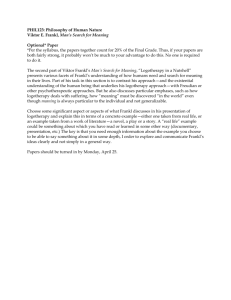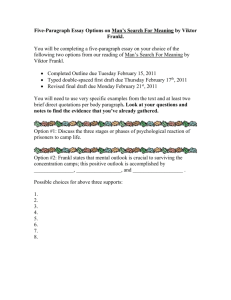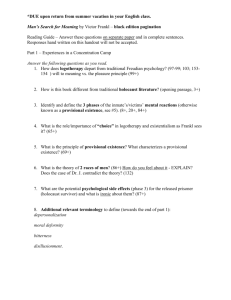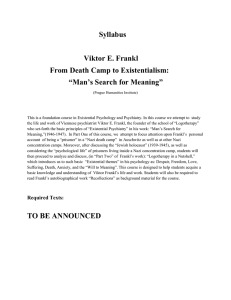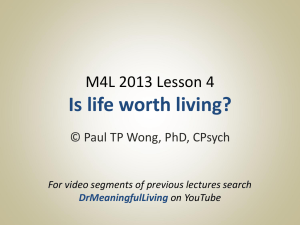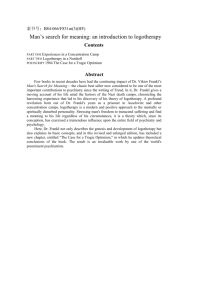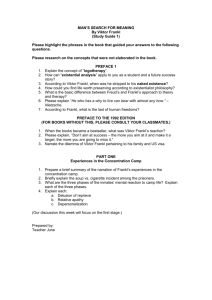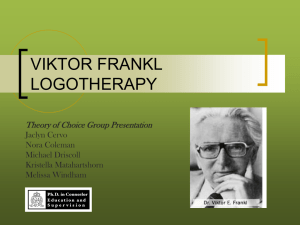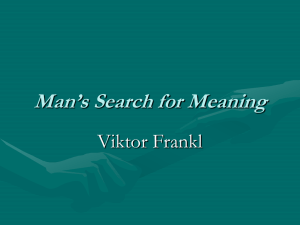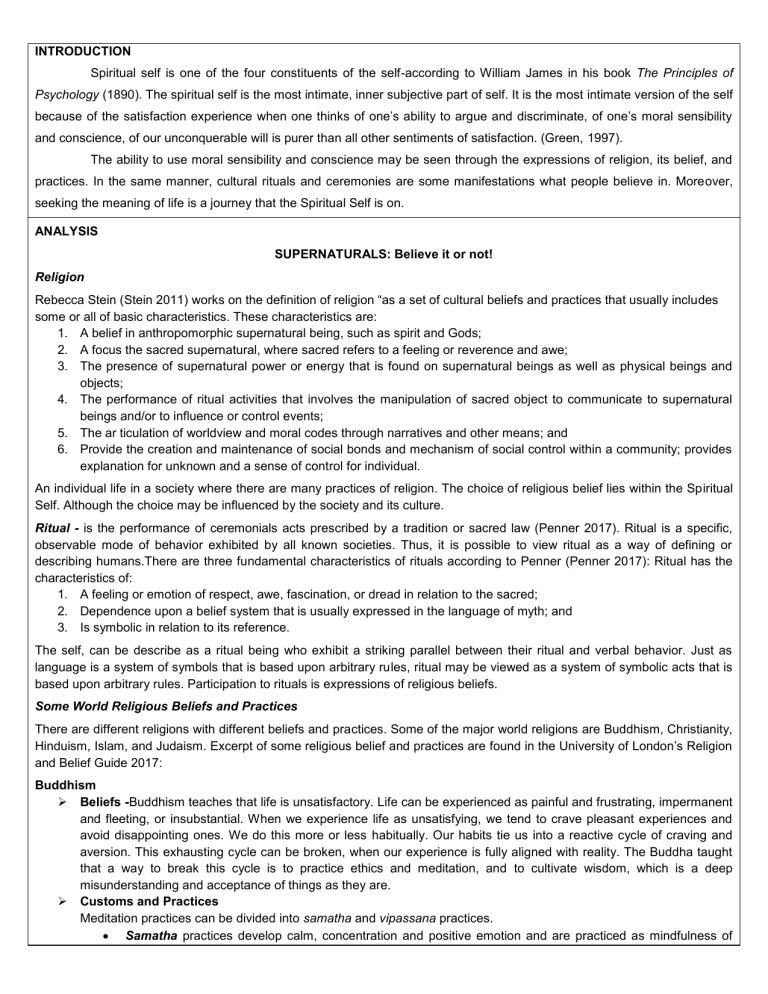
INTRODUCTION Spiritual self is one of the four constituents of the self-according to William James in his book The Principles of Psychology (1890). The spiritual self is the most intimate, inner subjective part of self. It is the most intimate version of the self because of the satisfaction experience when one thinks of one’s ability to argue and discriminate, of one’s moral sensibility and conscience, of our unconquerable will is purer than all other sentiments of satisfaction. (Green, 1997). The ability to use moral sensibility and conscience may be seen through the expressions of religion, its belief, and practices. In the same manner, cultural rituals and ceremonies are some manifestations what people believe in. Moreover, seeking the meaning of life is a journey that the Spiritual Self is on. ANALYSIS SUPERNATURALS: Believe it or not! Religion Rebecca Stein (Stein 2011) works on the definition of religion “as a set of cultural beliefs and practices that usually includes some or all of basic characteristics. These characteristics are: 1. A belief in anthropomorphic supernatural being, such as spirit and Gods; 2. A focus the sacred supernatural, where sacred refers to a feeling or reverence and awe; 3. The presence of supernatural power or energy that is found on supernatural beings as well as physical beings and objects; 4. The performance of ritual activities that involves the manipulation of sacred object to communicate to supernatural beings and/or to influence or control events; 5. The ar ticulation of worldview and moral codes through narratives and other means; and 6. Provide the creation and maintenance of social bonds and mechanism of social control within a community; provides explanation for unknown and a sense of control for individual. An individual life in a society where there are many practices of religion. The choice of religious belief lies within the Spiritual Self. Although the choice may be influenced by the society and its culture. Ritual - is the performance of ceremonials acts prescribed by a tradition or sacred law (Penner 2017). Ritual is a specific, observable mode of behavior exhibited by all known societies. Thus, it is possible to view ritual as a way of defining or describing humans.There are three fundamental characteristics of rituals according to Penner (Penner 2017): Ritual has the characteristics of: 1. A feeling or emotion of respect, awe, fascination, or dread in relation to the sacred; 2. Dependence upon a belief system that is usually expressed in the language of myth; and 3. Is symbolic in relation to its reference. The self, can be describe as a ritual being who exhibit a striking parallel between their ritual and verbal behavior. Just as language is a system of symbols that is based upon arbitrary rules, ritual may be viewed as a system of symbolic acts that is based upon arbitrary rules. Participation to rituals is expressions of religious beliefs. Some World Religious Beliefs and Practices There are different religions with different beliefs and practices. Some of the major world religions are Buddhism, Christianity, Hinduism, Islam, and Judaism. Excerpt of some religious belief and practices are found in the University of London’s Religion and Belief Guide 2017: Buddhism Beliefs -Buddhism teaches that life is unsatisfactory. Life can be experienced as painful and frustrating, impermanent and fleeting, or insubstantial. When we experience life as unsatisfying, we tend to crave pleasant experiences and avoid disappointing ones. We do this more or less habitually. Our habits tie us into a reactive cycle of craving and aversion. This exhausting cycle can be broken, when our experience is fully aligned with reality. The Buddha taught that a way to break this cycle is to practice ethics and meditation, and to cultivate wisdom, which is a deep misunderstanding and acceptance of things as they are. Customs and Practices Meditation practices can be divided into samatha and vipassana practices. Samatha practices develop calm, concentration and positive emotion and are practiced as mindfulness of breathing and development of loving kindness (Metta Bhavana). Vipassana practice aim at developing insight into reality. Developing and cultivating wisdom happens through studying and reflecting the Dharma, the Buddha’s teaching. Through study and reflection, we deepen our understanding of what reality is and how we can best live our lives according to that understanding. Buddhist ethics is an ethics of intention in which the key principle is non-violence. Buddhist celebrate a number of festivals timed to the full moon: Parinirvana Day in February, Buddha Day (Wesak) in May, Dharma Day in July, Padmasambhava Day in October and Sangha Day in November. All are important events to celebrate together and to contemplate key teachings of the Buddha. Christianity Beliefs- Christians believe that God became fully present in the world in the person of Jesus Christ of Nazareth. They also believe that Jesus Christ’s dying on the cross, made Him a sacrifice to reconcile all humanity with their creator. They believe he rose from the dead and has sent the Spirit of God to renew and inspire people in the world today. Consequently, Christians have a distinctive understanding of God as a trinity: Father (Creator), Son (Redeemer), and Holy Spirit (Sustainer), while still emphasizing the unity of God. Their scriptures consist of four different accounts of the life of Jesus (Gospels), an account of life among the earliest disciples, a prophecy about the future, and a number of letters to early Christians communities. Many of these letters were written by Saint Paul, a former opponent of Jesus’ early followers who had a powerful conversion experience and went on to expound much of Christian thought and practice. These different books compromise the New Testament which Christians add to the Old Testament, the Hebrew scriptures of the Jewish faith. The Old Testament and the New Testament is called the Holy Bible. Custom and Practices- One becomes a Christian through the Sacrament of Baptism (water ceremony) that symbolizes a sharing in the death and resurrection of Jesus. This is an initiation into the life of the Church which Christians believe to be the body of Christ in the world today. Christians pray, worship, and read and study the Bible together. They also follow Jesus’ instruction of taking bread and wine, and declaring these as his body and blood offered in sacrifice for all through the Sacrament of holy Communion. Jesus identified himself with the poor and homeless, and was criticized for associating himself with others who were socially outcast. So, Christians believe that aside from teaching others about Jesus, they should work for peace and social justice. The principal Christian festivals are Christmas (celebrated on 25 December by most Christians), when the birth of Jesus is remembered, and Easter (which varies according to the lunar calendar) when Jesus’ resurrection from the dead is celebrated. Hinduism Beliefs The term “Hinduism” was coined as recently as the 19th century to cover a wide range of ancient creeds, textual traditions, and religious groups. Thus, Hinduism has no single founder, doctrine, or religious authority. Hinduism is best understood as a complete way of life, a path of sanctification, and discipline that leads to a higher level of consciousness. This path is known as Dharma, the ancient law. Hindus are often thought to be polytheists but most claim to believe in one supreme god who is incarnated in many forms. Hindus revere a body of texts as sacred scriptures known as the Vedas. Veda is a Sanskrit word meaning knowledge and many of these scriptures concerned with Dharma. Other important texts include the great epics of the Mahabharata and Ramayana. The Bhagavad Gita (part of the Mahabharata) is very popular in the west. Hindus believe that existence is a cycle of birth, death and rebirth, governed by karma, a concept whereby beneficial effects are derived from past beneficial actions. Hindus believe that the soul passes through a cycle of successive lives and its next incarnation is always dependent on how the previous life was lived. Customs and Practices Hindus follow the lunar calendar and particular days are set aside during the week and month to honoparticular manifestations of God. The main festivals are celebrated in different ways by different communities. The most commonly celebrated festivals are Diwali, the festival of Lights, and Navratri, nine nights which celebrated the triumph of good over evil. This takes place twice a year. Islam Islam is an Arabic word which means willing submission to God. The root of the word Islam comes from a word meaning peace and Muslims believe it is the way of peace as laid down in the Quran. The Arabic word Allah means One God, and at the heart of the Muslim faith is belief in the unity and universality of God. Muslims also believe in the unity of mankind, under one father, Adam, and have strong sense of the Muslim community or Ummah and an awareness of their solidarity with all Muslims worldwide. Muslims believe that God has sent a succession of prophets such as Adam, Noah, Abraham, Jacob, Moses, Jesus, and see Mohammed as the last and final prophet. These were recorded in Islam’s Holy Book is seen as inadequate. Customs and Practices Islam has five pillars that represent the foundation of Islamic worship and practice; Shahada: There is no God but the one true God and Mohammed is his messenger.” Salat: prayer five times a day at a given time. Zakat: two and a half percent of a Muslim’s assets over a given specified amount is given in welfare tax to benefit the poor. Hajj: an annual pilgrimage to Mecca, which is a requirement at least once in a lifetime for those who can afford it. Sawm; during the month of Ramadan (the ninth month of the Islamic lunar calendar), Muslims are required to abstain from Food, drink, and sexual acts from dawn until sunset. The end of Ramadan marks the beginning of the festival of Eid ul-Fitr when Muslims visit the Mosque, give charity, exchange presents and cards, and celebrate with family and friends. Eid ul-Adha coincides with the completion of the Hajj and unites the whole Islamic community. Judaism Beliefs The Jewish people believe themselves to be descended from a Semitic tribe that originated in the land of Canaan in the Middle East. Their early history is told in the Hebrew scriptures which recount how God promised to Abraham, a trader and leader of a nomadic tribe, that his descendants would be the father of a great nation. Abraham’s grandson Jacob had twelve sons who became ancestors of the twelve tribes of Israel. They were enslaved in Egypt and the book of Exodus tells how they were liberated under the leadership of Moses. For many years, they wandered in the wilderness, during which time God revealed to Moses the Torah, or Law, which constitutes the Jewish way of life. After Moses’ death the tribes eventually conquered the promise Land with the help of God. Jews believes of the coming of the Messiah, the Savior. Study and interpretation of the Torah is an integral part of Jewish life. It covers family relationships, social interaction and good commercial practice, as well as setting out the religious rituals that are still celebrated today. Customs and Practices The Jewish Sabbath begins on Friday evening at sunset and is an important time when families gather for the Sabbath meal. There are five festivals on which observant Jews are forbidden to work. The New Year (Rosh Hashanah) falls in the autumn and followed ten days later by the most solemn day of the year, the Day of atonement (Yom Kippur). The other major festivals are known as the three pilgrim festivals: Passover (Pesach) in the spring, Pentecost (Shavuot) that occurs seven weeks later, and Tabernacles (Sukkot) that takes place in the autumn. Jewish food laws are highly complicated, prohibiting certain animals and shellfish. Acceptable animals must be slaughthered in such a way as renders them kosher. Religious beliefs, rituals, practices, and customs are all part of the expression of the Spiritual Self. What to believe and how to manifest the belief is entirely dependent to the individuals, to the Self. A person might believe that there is higher being, a supernatural being, usually termed God. But not necessarily wants to be affiliated or identified with a certain religious group. Others may have their own religious practices, which are perceived to be contrary to the practices of other groups. Religious beliefs and practices therefore are formed relative to its context and culture. Finding and Creating Meaning of Life: Viktor Frankl Institute of Logotherapy Viktor E. Frankl Born in Vienna (1905- 1997). Died due to heart failure Involved in Socialist young organizations and became interested in psychiatry. Earned a medical degree from the University of Vienna in 1930 and became in-charge in the Vienna Hospital Treatment for Females’ who attempted to suicide. Married to Tilly Grosser. Frankl lived through the horrors of the Holocaust, a prisoner in Auschwitz and Dachau. He overcame it stoically and it laid the foundation of a very personal type of therapy, logotherapy. LOGOTHERAPY - - known as “Third Viennese School of Psychotherapy.” Father of the logotherapy involves helping a patient find personal meaning in life. Logos is a Greek word translated as “Logotherapy focuses on the future.” proposes that meaning in life can be discovered in three distinct ways: 1. By creating a work or doing a deed. 2. By experiencing something or encountering someone. 3. By the attitude that we take toward unavoidable suffering. 4. Maintains man always has the ability to choose; no matter the biological or environmental forces. Important aspect of this theory is known as the “tragic triad,” pain, guilt, and death. Case for a tragic Optimism- optimism in the face of tragedy and in view of the human potential, which at its best always allows for”: Turning suffering into human achievement and accomplishment Deriving from guilt the opportunity to change oneself for the better Deriving from life’s transitoriness as incentive to take responsible action. Basic concepts of Franklian Psychology Life has meaning under all circumtances Main motivation for living is our will to find meaning in life Freedom to find meaning Basic Assumptions Logotherapy consists of six basic assumptions that overlap with the fundamental constructs and ways of seeking meaning listed above: 1. Body, Mind, and Spirit- The human being is an entity that consists of a body (soma), mind (psyche), and spirit (noos). Frankl argued that we have a body and mind, but the spirit is what we are, or our essence. Note that Frankl's theory was not based on religion or theology, but often had parallels to these. 2. Life Has Meaning in All Circumstances- Frankl believed that life has meaning in all circumstances, even the most miserable ones. This means that even when situations seem objectively terrible, there is a higher level of order that involves meaning. 3. Humans Have a Will to Meaning- Logotherapy proposes that humans have a will to meaning, which means that meaning is our primary motivation for living and acting and allows us to endure pain and suffering. This is viewed as differing from the will to achieve power and pleasure. 4. Freedom to Find Meaning- Frankl argues that in all circumstances, individuals have the freedom to access that will to find meaning. This is based on his experiences of pain and suffering and choosing his attitude in a situation that he could not change. 5. Meaning of the Moment- The fifth assumption argues that for decisions to be meaningful, individuals must respond to the demands of daily life in ways that match the values of society or their own conscience. 6. Individuals Are Unique- Frankl believed that every individual is unique and irreplaceable. Aims of Franklian Psychotherapy Become aware of spiritual resources Make conscious spiritual resources Use “defiant power of the human spirit” and stand up against adversity. Frankl’s Sources of Meaning Popovo 2017 discussed Viktor Frankl’s work. There are three possible sources of meaning. Work, by doing something significant Love, by caring for another person Costello (2015) captured Viktor Frankl’s message. The “ultimate secret on the spiritual foundation of life is that Love is salvation and joy eternity. Courage during difficult times Suffering-essential piece not only of existence but of the meaningful life. Meaning in life = meaning in suffering Ineradicable part of life LESSON END… REFERENCES Alastra, et.al (2018). Understanding the Self. Mainla: REX Book Store.
